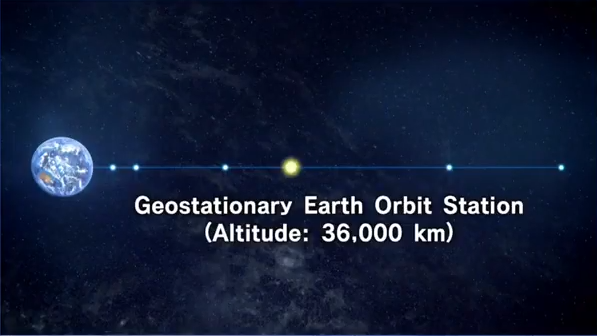Japan's Space Elevator: The Future Of Space Exploration
In my childhood, I often used to imagine constructing a very long ladder to space so that I could touch the stars and moon, something most of you also did, I guess. As I grew and learned some space stuff, I realized it isn't a something a child like me could achieve and even for the experts, it's an impossible task till date(or actually it's not an individual's task).
That was my knowledge on the matter until very recently I got to watch a video, which said that the Japanese construction company Obayashi Corporation is going to build a Space Elevator. Japan has always been at the forefront of technological advancement. So here I'll be discussing how they'll do it.

A Space Elevator is a planet-to-space transportation system extending from earth to outer space. The system comprises a cable that extends from the surface of the Earth(Equatorial Point) to outer space with the other end beyond the Geostationary Orbit(36,000 km).

The Idea
The idea of a Space Elevator was imagined for the first time in 1895 by the Russian scientist Konstantin Tsiolkovsky which was inspired by the idea of the Eiffel Tower. His idea was based on the compressive strength of the material of which the structures are made. The intactness of any highrise structure depends on how good a material is on being compressed. We can add some more height by making the foundation part wider. However, building such a tall tower is impractical as the tower would collapse under its own weight as there's no material with so high compressive strength.
However, this idea seemed unrealistic until a few decades ago when a new material called Carbon Nanotube was invested. A Carbon Nanotube is a form(other forms of carbon are diamond and graphite) of carbon with a cylindrical structure. Carbon Nanotubes are best-known for their tensile strength and stiffness in material science. They are 100 times stronger and only one-sixth as heavy. Carbon nanotubes are a tube-shaped superstrong material with the diameter in the nanometer range.

The Construction
The modern space elevator concept is based on tensile strength instead of compressive strength. The high tensile strength of Carbon Nanotubes is what led to this idea. But, instead of building a tower with its base on earth, this idea considers building the structure the exact opposite way. The Japanese team has plans to stretch a cable made of carbon nanotubes tethered on earth to a point beyond the geostationary orbit. But, how do they plan to install the facility?
One way is to launch the cable using a rocket. But, though a rocket seems like it moves straight above, it actually revolves around earth many times before reaching its target orbit. The cable would get tangled around the earth and that would be a disaster for us. Hence, it is certainly not an option.
The solution came from Yuri Artsutanov, a Russian scientist. His idea was to use a geostationary orbit. A geostationary orbit is a circular orbit at an altitude of 36,000 km above the equator and in a direction of the rotation of the earth. In this orbit, an object moving around earth takes exactly 24 hours i.e. the time taken by earth to move around its own axis. Hence, the object is always above a certain point on the equator and looks motionless. In 1960s Artsutanov proposed that earth could be connected to a space station at the geostationary orbit by lowering a cable from the geostationary orbit to earth.

In 2012, the Japanese team announced their plan to build the first space elevator in the world. The whole process starts with the launch of a construction spacecraft carrying the cable using a rocket and put it on the geostationary orbit. From the construction spacecraft, the cable will be lowered to earth. However, the strong force of gravity will attract the cable and pull the spacecraft down. Another cable will now be extended in the opposite direction from the spacecraft as a counterweight. By the time the cable reaches earth, the opposite tip will be 96,000 km away.

One more problem is that the descent of the cable will be affected by the rotation of the earth. Hence, the descent won't be in a straight line. It will descend sideways towards the east. Hence, a thruster will be installed at the tip of the descending cable which will maintain the vertical descent by resisting the sideward motion. Now, the cable will descend towards earth at a speed of 15 km per hour.
When the cable reaches the atmosphere, a balloon will be opened to slow it down and finally it will land on earth. This cable is not strong enough to sustain the weight to be carried. Some machine will climb up to reinforce the cable. The initial cable is only a few centimeters thick and it is not so strong. So, hundreds of such cables are combined to form a very strong cable that can sustain the required weight. Most of the construction period is thus cable construction time.
Power Source
The power source for the elevator is a major concern. The elevator will run on electricity. Loading a battery on the elevator will increase its weight and hinder its motion. Hence, the team has plans to power it up externally. How to do that?
The answer is laser beams. Laser beams do not disperse much to a very long distance and for this reason, energy can be directed to a certain point. Such Laser beams will be directed from earth towards the solar plates installed at the lower part of the elevator which will power up the elevator. A team at NASA is holding experiments to power up climbers using Laser beams.
Thick clouds or rain can block the Laser beams and the power in the elevator is shut down. So the team is considering multiple options. One solution is to install Laser source at multiple locations and direct the Laser beam from the location where the weather is clear. Another option is to install the Laser source at the geostationary orbit.
Problem With The Length of The Cable
A demerit of carbon nanotubes is that it's breaking length is very short(5,000 km) as compared to the required length of the cable. Breaking length is the length of the material to which it can sustain its own weight. The problem is solved naturally by gravity itself. As the height increases, the strength of gravity decreases accordingly. Hence, the breaking length of the carbon nanotube is smaller on the earth and it increases as we move upward. In this way, the length of the cable can be made longer to reach the geostationary orbit. We can further increase the length by making the cable wider at the top.
The Features
There will be different stations along the length of the elevator. At the distance of geostationary orbit, there will be a space station which will be weightless as the centrifugal force will balance the gravity of earth. This station will be primarily used for space research and space tourism purposes. Massive solar plates will be installed which will power up the station.
.png)
Moving above the length, at an altitude of 57,000 km there will be another station which will be called the Mars Gate. Due to its distance from earth, it will be moving around earth 1.5 times faster than the station at the geostationary orbit. This speed will be used to launch spacecraft to Mars.

Moving above, at the tip of the elevator at a distance of 96,000 km there will be another station. It will be moving faster than even the Mars Gate. This speed will be used for launching spacecraft to planets and asteroids that are beyond mars.
Completion Period
The team has plans to begin their work by 2025 and complete it by 2050. Most of the construction time will be to install the cable, reinforce it and get it ready for the ride.
Benefits
When the project is completed, the overall cost of any space exploration will cost drastically. It requires a lot of energy to launch spacecraft and satellites from earth directly. We can build launch stations( e.g the Mars Gate) on this space elevator which will reduce the energy requirement and will ultimately reduce the costs of space exploration. Moreover, after the completion of the first space elevator, it will reduce the construction cost of more space elevators.
We can see that the science fictions that we see in movies are slowly taking shape of reality. Everything that seemed impossible earlier is now being realized. We could hope to see more such unbelievable works with our eyes in future. I really want the space elevator to be ready in my lifetime only so that I could have a ride of the technology of the future before I die. Won't you want it too?
References:
- Obayashi Corporation: The Space Elevator Construction Concept
- Gaia: JAPAN’S SPACE ELEVATOR EXPECTED TO BE BUILT BY 2050
- Howitworks: How Space Elevators Will Work
- Why Space Elevators Could Be the Future of Space Travel
- Upward Bound: Space Elevators
- [New Documentary] Space Elevator Documentary 2017
- Space Elevator Connecting Earth To Space Station
- Space Elevators

If you love dreaming and learning science then please follow me at
@physics-o-mania
Don't Forget to Read My Previous Articles:
- The Human Computer: Shakuntala Devi
- Quantum Computing: The Next Generation Computing Giants
- Nikola Tesla: The Man of Electricity
- Quantum Cryptography and China's Quantum Satellite : A New Era of Hack-Proof Communication
- Einstein : The Person Who Made People Love Physics
- Mohenjo-Daro : A 4000 Years Old but Modern City
- Mining The Lunar Surface : A New Race in Space?
- The ITER Project: Future of Endless Clean Energy?
- ISRO : The New Glamor in Space Race
- The Quest for the Grand Unification : The Theory of Everything
- The Strange Face of Reality : The Quantum Realm
Thank you for reading my content !!

In. Cred. Ible. When I first saw your article a bunch of questions were raised in my mind about the material they would use, and how they would counteract the orbital motion, but you answered them all. Very well done. I also write tech articles about hardware and crypto and publish radio shows, so come check it out if you're interested.
Thank you...do share me your new articles. Following you
Thanks man. I really appreciate that.
Thank you...do share me your new articles. Following you
This post has been rewarded with 30% upvote from @indiaunited-bot account. We are happy to have you as one of the valuable member of the community.
If you would like to delegate to @IndiaUnited you can do so by clicking on the following links: 5SP, 10SP, 15SP, 20SP 25SP, 50SP, 100SP, 250SP. Be sure to leave at least 50SP undelegated on your account.
Please contribute to the community by upvoting this comment and posts made by @indiaunited.
And here I was thinking a rocket goes straight up into space. Glad I picked this up here. There's no telling what one would learn on the steemstem tag everyday.
Superb article by the way. If the space elevator finally sees daylight, even I could fulfil one of my dreams of seeing space. We hope it wouldn't be too expensive though.
Thank you @pangoli
I wish I can one day have a ride on it.
@firepower @shenoy @sjennon @varunpinto
You got a 20.70% upvote from @upmewhale courtesy of @physics-o-mania!
Earn 100% earning payout by delegating SP to @upmewhale. Visit http://www.upmewhale.com for details!
Most kewl information and really gets you thinking and drawn in about the future and its possibilities! Nice 1 :D
Thank you @clubfungus
Japan always thinks ahead of the world@physics-o-mania